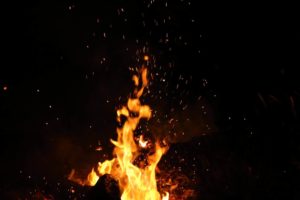Short Answer: When creosote builds up in a chimney, it can ignite and burn. That’s a chimney fire. That fire can reach temperatures as high as 2000° F; and it can wreak havoc on the insides (and sometimes the outside) of a chimney. Resulting damage can lead to premature deterioration of the structure at best. It can endanger a home and its occupants at worst.
We can find our substantiation for this opinion in The Facts about Chimney Fires – Causes & Cures — a brochure written by the Chimney Safety Institute of America. Most of what is in this blog will be coming directly from that information piece. Some of it is directly quoted, some of it is paraphrased.
A chimney fire can be impressive. Chimney fires have been described as creating:
- loud cracking and popping noise
- a lot of dense smoke, and
- an intense, hot smell
 Chimney fires can be noisy and dramatic enough to be seen by neighbors or passers-by. Flames or dense smoke may shoot from the top of the chimney. Some report a low rumbling sound that reminds them of a freight train or a low flying airplane.
Chimney fires can be noisy and dramatic enough to be seen by neighbors or passers-by. Flames or dense smoke may shoot from the top of the chimney. Some report a low rumbling sound that reminds them of a freight train or a low flying airplane.
However, those are only the chimney fires you know about. Slow-burning chimney fires don’t get enough air or have fuel to be dramatic or visible. However the temperatures they reach are very high and can cause as much damage as their more spectacular cousins.“
So…what is creosote and how can you minimize its collection in your chimney? Let’s consult The Facts About Chimney Fires…
“The by-products of combustion (smoke, water vapor, gases, unburned wood particles, hydrocarbon volatiles, tar fog and assorted minerals) exit through a chimney during the process of using a fireplace or wood stove.
As these substances exit the fireplace or wood stove, and flow up into the relatively cooler chimney, condensation occurs. The resulting residue that sticks to the inner walls of the chimney is called creosote.
Creosote is black or brown in appearance. It can be crusty and flaky…tar-like, drippy and sticky…or shiny and hardened. All forms can occur in one chimney system. Whatever form it takes, creosote is highly combustible. If it builds up in sufficient quantities – and the internal flue temperature is high enough – the result could be a chimney fire.
Certain conditions encourage or accelerate the buildup of creosote on the chimney walls
- Restricted air supply
- closing the glass doors
- failing to open the damper wide enough
- the lack of sufficient make-up air to move heated smoke up the chimney rapidly
- closing down the stove damper or air inlets too soon or too much.
- unseasoned wood
- so much energy is used initially just to drive off the water trapped in the cells of the logs– keeps the resulting smoke cooler, than if seasoned wood is used.
- cooler than normal chimney temperatures
- exterior chimneys
- uninsulated chimneys”
How do you know if you’ve had a chimney fire? For answers, let’s go back to The Facts About Chimney Fires…
We’ve learned that a chimney fire can occur without anyone being aware of it. So….
”…it’s important to have your chimney regularly inspected by a CSIA Certified Chimney Sweep. Here are the signs that a professional chimney sweep looks for:
- “Puffy” or “honey combed” creosote
- Warped metal of the damper, metal smoke chamber connector pipe or factory-built metal chimney
- Cracked or collapsed flue tiles, or tiles with large chunks missing
- Discolored and/or distorted rain cap
- Heat-damaged TV antenna attached to the chimney
- Creosote flakes and pieces found on the roof or ground
- Roofing material damaged from hot creosote
- Cracks in exterior masonry
- Evidence of smoke escaping through mortar joints of masonry or tile liners”
Blue Sky Chimney Sweeps |Bless Your Hearth can help you with….
Inspections & Proper Maintenance
“Clean chimneys don’t catch fire. Make sure a CSIA Certified Chimney Sweep inspects your solid fuel venting system annually, and cleans and repairs it whenever needed. Your sweep may have other maintenance recommendations depending on how you use your fireplace or stove.”
Visit http://www.csia.org to see the complete brochure: The Facts about Chimney Fires – Causes & Cures
